Categories
Subjects
Authors
Artists
Venues
Locations
Calendar
Filter
Done
March 8, 2024 – Review
Amalia Pica’s “Aula Expandida”
Noah Simblist
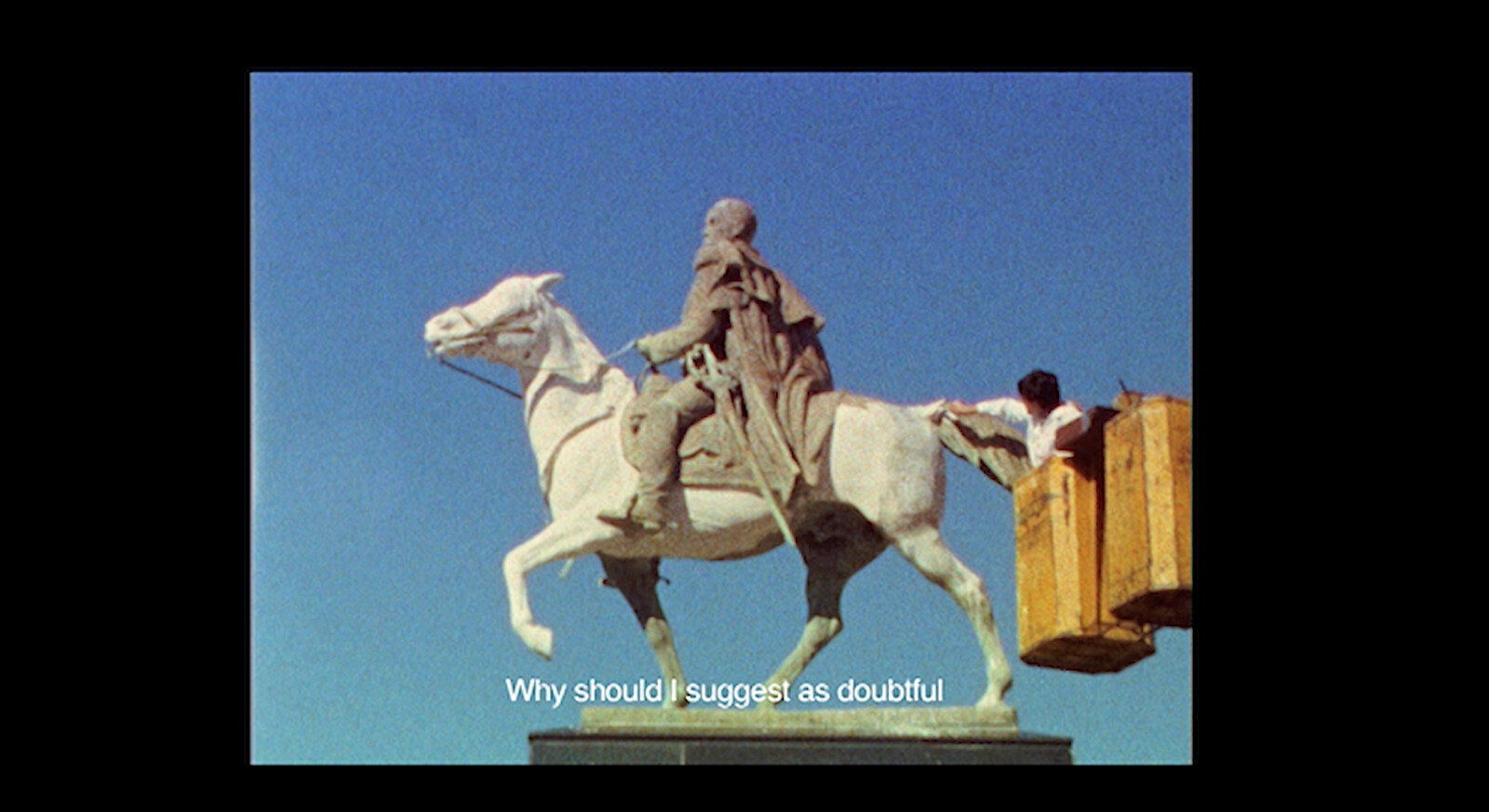
How might our understanding of education better incorporate communication, participation, and play? And what would be the consequences of that expanded approach? Such questions have been at the center of Amalia Pica’s work for many years, drawing partially on her early experience as a primary school teacher. Her first solo exhibition in New York attends to the manifold aspects of learning across a group of collages, sculptures, and video works organized around a new interactive installation.
Two understated large-scale graphite and watercolor drawings, School sheets in adjusted scale (or an exercise in how to go back to all the things I hadn’t thought of yet) #1 and #2 (both 2011), are based on notebook paper with “Rivadavia” printed in an elegant cursive in the margin. This references Bernardino Rivadavia, the first president of the London-based artist’s birth country of Argentina, using a font based on his signature. The stamping of state power into the very books in which young people learn how to write signals the reproduction of the ideological subject through a form of repeated inscription. This has chilling implications in the context of the military dictatorship (1976–83) into which Pica was born.
Her 2008 video On Education depicts …
December 7, 2023 – Review
Shilpa Gupta
Paul Stephens

Recent New York Times headlines point to American perceptions of India’s increasingly prominent role in global affairs. “Can India Challenge China for Leadership of the ‘Global South’?” “Will This Be the ‘Indian Century’?” “The Illusion of a US-India Partnership.” “US Seeks Closer Ties With India as Tension With China and Russia Builds.” “US Says Indian Official Directed Assassination Plot in New York.” “An Indian Artist Questions Borders and the Limits on Free Speech.”
The last headline refers to Mumbai-based Shilpa Gupta, whose work obliquely explores the emergent global polycrisis (a term popularized by Adam Tooze) in which India plays a central part. Although Gupta’s art is deeply engaged with contemporary political events, it is not headline-driven. It resists didacticism, in part, through being polyvocal, as exemplified in her standout installation Listening Air (2019–23). Defying simple description and rewarding patient immersion, Listening Air consists of multiple microphones-turned-speakers that play songs of labor and resistance from around the world. As the songs fade in and out, listener-viewers in the dimly lit room slowly begin to perceive themselves as members of a temporary community. The effect is ethereal and meditative.
Gupta’s two concurrent New York exhibitions, at Amant and Tanya Bonakdar Gallery, accord …
February 10, 2021 – Review
Liu Shiyuan’s “For Jord”
Fanny Singer
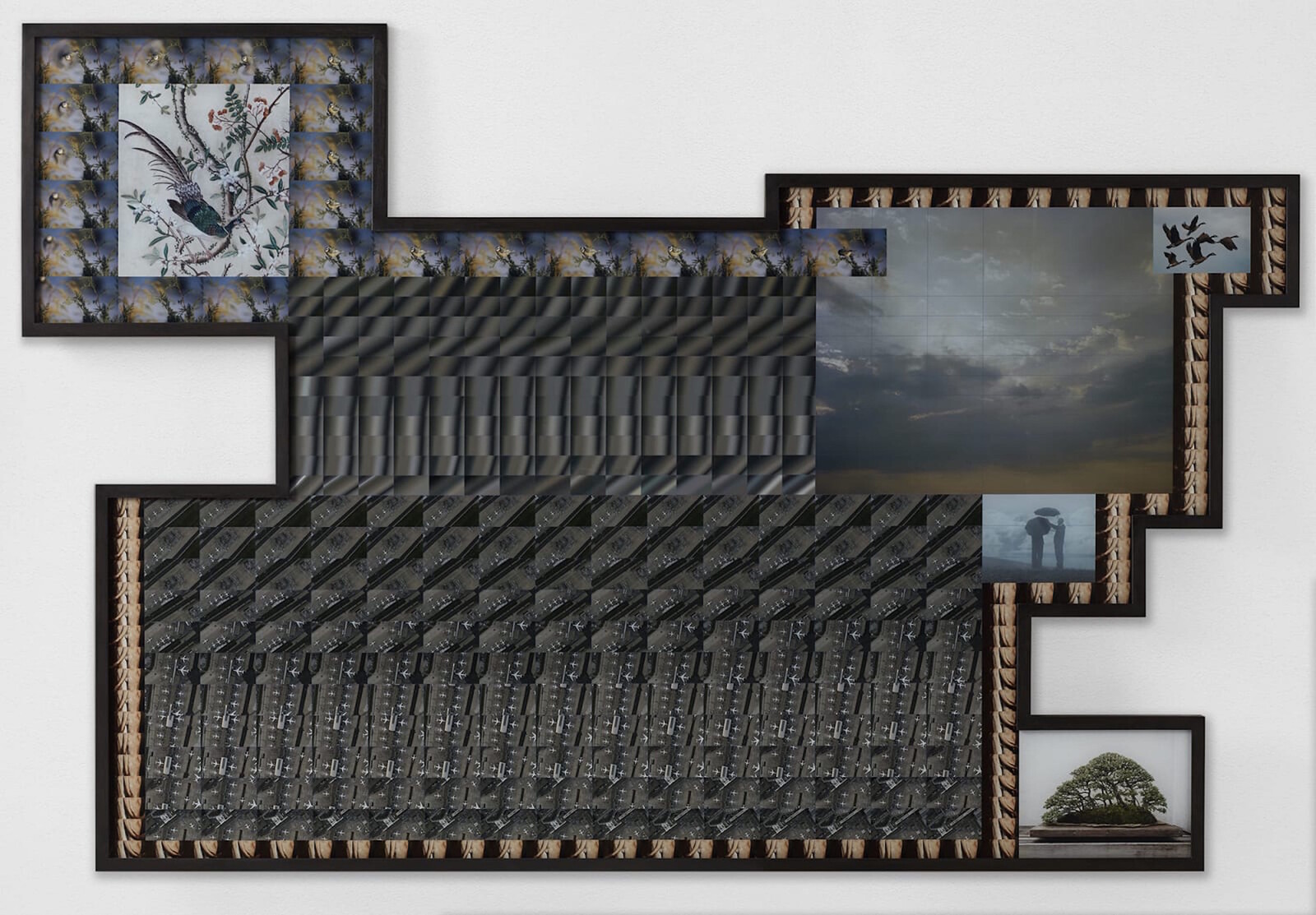
As I left Liu Shiyuan’s first solo exhibition in Los Angeles, I kept tripping over lines from a Robert Hass poem, “Meditation at Lagunitas”: “because there is in this world no one thing/ to which the bramble of blackberry corresponds,/ a word is elegy to what it signifies./ […] After a while I understood that,/ talking this way, everything dissolves: justice,/ pine, hair, woman, you and I.” This poem was published in 1979, when the internet as it exists today wasn’t so much as a dream, but the dissolution that Hass describes is in many respects the subject of Liu’s forensic examinations of post-internet culture. Since 2007, the Beijing-born Liu (who splits her time between China and Denmark) has devoted herself to unpacking, interrogating, even satirizing, internet semiotics. At a moment in history in which an ever-increasing percentage of the global population has been compelled online, there is a poetry to Liu’s search for meaning in a digitally atomized world.
Liu’s exhibition is centered on a fictional—and purely conceptual—character named “Jord” (after whom, or what, the show is titled). Jord is both a noun and a name in Danish, translating, respectively, to “land” or “soil,” and “divine being” or “peace.” …
April 15, 2016 – Review
Mark Dion’s “The Library for the Birds of New York and Other Marvels”
Thyrza Nichols Goodeve
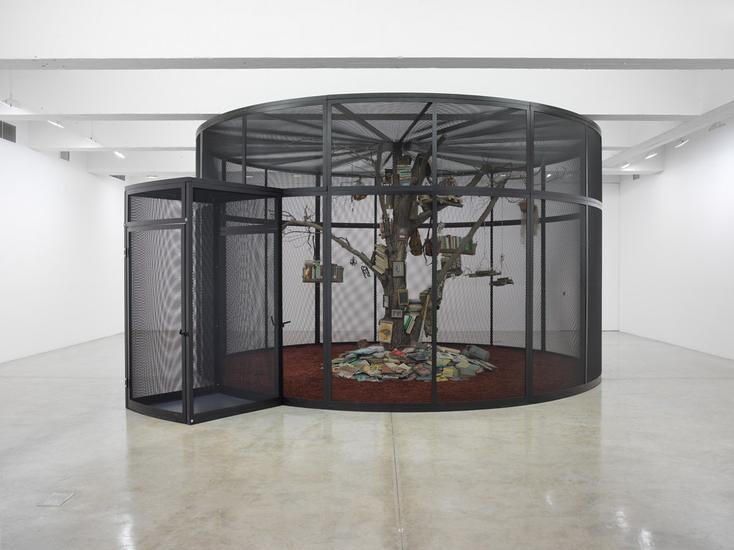
While Charles Baudelaire’s definition of “the ephemeral, the fugitive, and the contingent” is a familiar truism of contemporary understandings of “the modern,” Baudelaire’s casual, even offhand 1863 observation, “nature, being none other than the voice of our own self-interest,” is less well known. Yet if one were to draw a line from Baudelaire’s nineteenth-century evocation of the early days of modernism to our twenty-first century epoch of over-modernism(s), who but the artist Mark Dion would affirm Baudelaire’s prescient observation? As Dion knows, and explores once again in his exhibition “The Library for the Birds of New York and Other Marvels,” we live in an era when this self-interest has cast the very planet we live on into a melancholy condition of the “ephemeral,” “fugitive,” and “contingent.”
While a quick impression of the works on view suggests Dion has broken no new ground, and may even be recycling what have become all-too familiar tropes, it is the contingent, the detail, the specificity of the subject matter of each piece, that reveals once again Dion’s cogent, nuanced, and up-to-the-minute dissection of this self-interest we call nature. For instance, the formal elements (monumental bird cage, dead tree trunk, shelves and piles of books, photographs …
June 25, 2014 – Review
“The Bigger Picture: Work from the 1990s”
Alan Gilbert
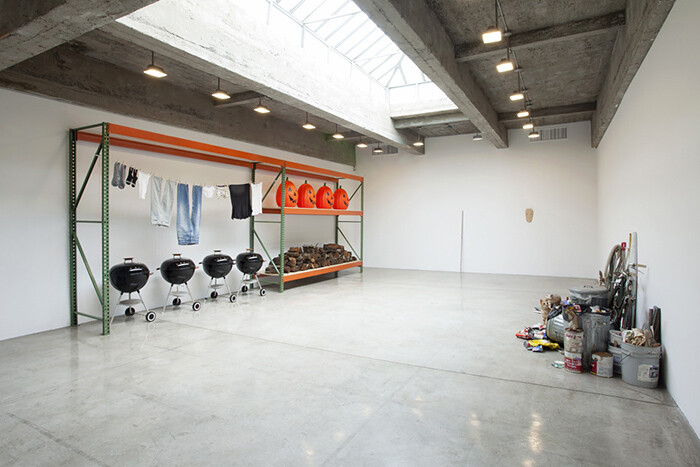
The 1990s art world began with the rumblings of multiculturalism and identity politics and closed with a resurgent art market interested in—as it frequently is—painting, and figurative painting in particular: John Currin, Lisa Yuskavage, and the total ascendance of Gerhard Richter. In between these two moments a variety of forms proliferated, especially installation and new media works, and so it’s not a surprise that there isn’t much painting on display at Tanya Bonakdar Gallery’s own survey of the decade: “The Bigger Picture: Work from the 1990s.” In fact, the exhibition is as much a celebration of the gallery’s first twenty years as it is any kind of time capsule or historical summary of the period.
Although founded in New York’s SoHo in 1994, Tanya Bonakdar Gallery made the early move to Chelsea in 1998. International notables such as Phil Collins, Olafur Eliasson, Ernesto Neto, Sarah Sze, and Gillian Wearing all have work in “The Bigger Picture” as part of a mid-1990s openness that gradually evolved—paralleling the rise of social media—into a late 2000s state of anything goes. But the historical still registers, if mostly in terms of the trajectory individual artists took, as in Eliasson’s early experiments with perspective and perception …
July 8, 2013 – Review
"ambient"
Stephen Squibb
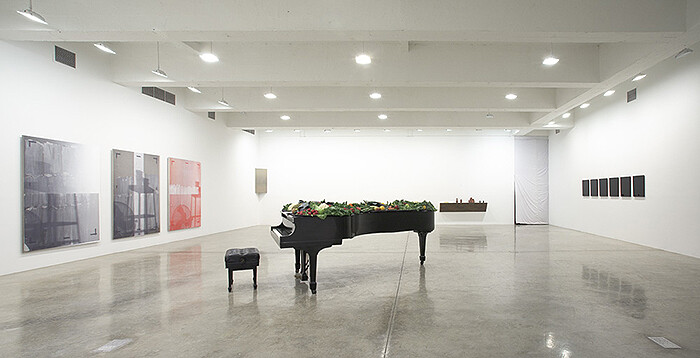
The title of the group show currently on view at Tanya Bonakdar, “ambient,” invites historical speculation. Where does ambience settle as an interpretive framework? The show even designates an event, of sorts, that puts forward ambience as an artistic strategy. The press release opens with an anecdote from the liner notes of Brian Eno’s 1975 Discreet Music. Apparently, Eno had located the origins of ambient music in something that happened to him while bedridden after an accident: “After a friend placed a recording of eighteenth-century harp music on the composer’s turntable before departing the room, he realized the stereo amplifier was at such a low level that the music (which was also playing only through a single channel) was nearly inaudible, blending with the ‘color of the light’ and ‘sound of the rain,’ and residing at or just beneath the threshold of perception.” We can read the works in “ambient” as evidence submitted to determine the subsequent significance of this innovation.
The production, in 1975, of things existing “at or just beneath the threshold of perception” superficially recalls two things: phenomenology—or the philosophical investigation and analysis of perception in the work of thinkers like Edmund Husserl and Maurice Merleau-Ponty—and Minimalism, whose …